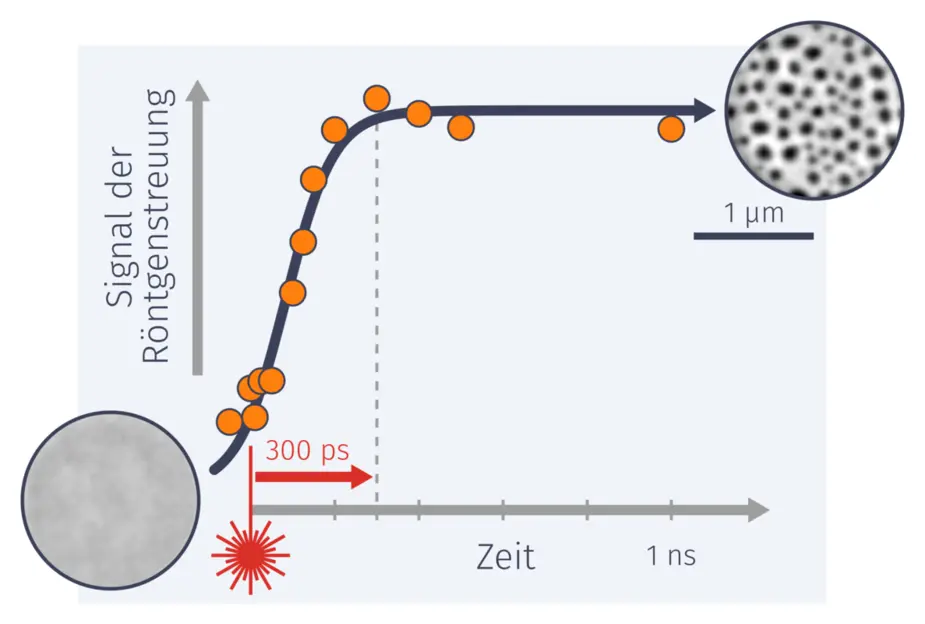Twisting magnetization with light
Laser pulses enable faster creation of skyrmions in magnets
A team of scientists led by the Max Born Institute (MBI), Berlin, Germany, and the Massachusetts Institute of Technology (MIT), Cambridge, USA, has demonstrated how tiny magnetization patterns known as skyrmions can be written into a ferromagnetic material faster than previously thought possible. The researchers have clarified how the topology of the magnetic system changes in this process. As reported in the journal Nature Materials, the findings are relevant for topological phase transitions in general, and may inspire new routes how to use magnetic skyrmions in information technology.
Magnetic skyrmions are tiny swirls in the magnetization of thin magnetic films, where the direction of magnetization points in different directions as shown schematically in the first Figure. It turns out that the particular magnetization pattern can be characterized according to its so-called topology – a mathematical concept to describe the shape or geometry of a body, a set or – as in this case – a physical field (see infobox on topology). Importantly, the topology of skyrmions is different from the simple uniform state where the magnetization points in the same direction everywhere. To change between the two spin patterns, also the topology of the system must be changed. This contributes substantially to the stability of the skyrmions but also makes their fast creation very difficult.
In their work, which employs imaging of nanometer-sized skyrmions with x-rays and electrons, the researchers were first able to show that a single laser pulse of sufficient intensity allows to create skyrmions with a particular topology – that is, the magnetization pattern swirls in a particular fashion only.
Next, they set out to understand how such a change of topology is mediated by the laser pulse by investigating how this transition from a uniform pattern to skyrmions proceeds in time. Towards that end, they performed x-ray scattering experiments at the x-ray free-electron laser European XFEL in Hamburg, Germany, where the deflection of the x-ray beam by the skyrmions is detected. Hitting the ferromagnetic thin film in its uniform state first with an optical laser pulse followed by an x-ray laser pulse, they could map out how size and spacing of the skyrmions evolve over time. The first surprising result was that the topological change was finished after 300 picoseconds, which is significantly faster than observed for skyrmions in any other ferromagnetic system before.
Comparing the experimental data with theoretical simulations, the team could infer how the topological transition comes about. The laser pulse promotes the system in a high-temperature state where the magnetization breaks up in small independently fluctuating regions, rapidly changing their magnetization direction. In this topological fluctuation state, the energy barrier for the nucleation of skyrmions is very much reduced, and they appear and disappear continuously. As the system cools down after laser excitation, some of the small skyrmion nuclei freeze out and subsequently grow to form the larger skyrmions, which have been observed in the initial imaging experiments.
Given that skyrmions can have a size in the range of ten nanometers and yet be very stable at room temperature, these findings may have interesting implications for future concepts of magnetic data processing and storage. Already today, the formation of “ordinary” bits on a magnetic hard drive is limited by the ability to switch very small yet stable bits with a magnetic field. Local heating by a laser is announced to be the next technology step in providing higher storage density, and the topological switching of skyrmions via laser pulses may add a new twist to that.
Info: Topology
The topology is a mathematical concept to describe and distinguish the shape or geometry of, e.g., bodies. In physics, this concept is also applied to vector fields such as the magnetization pattern in a thin film. Two bodies have the same topology if they can be transformed into each other only by so-called continuous transformations such as stretching, compressing, bending, and twisting. However, cutting and gluing are not allowed in this context. This leads to the result that a mug and doughnut share the same topology. Just imagine a mug made of modeling clay: When skillfully deforming the clay, it is possible to form the doughnut without cutting or gluing the clay at any point in the process. However, it is impossible to model a doughnut out of aspoon in this way. At some point you will have to cut the doughnut hole or glue two ends of a roll to end up with a doughnut. So spoon and doughnut can be distinguished by their different topology. In physics, it is often assumed that a certain energy barrier has to be overcome in order to change the topology of a system.
Original publication:
Observation of fluctuation-mediated picosecond nucleation of a topological phase
Felix Büttner, Bastian Pfau, Marie Böttcher, Michael Schneider, Giuseppe Mercurio, Christian M. Günther, Piet Hessing, Christopher Klose, Angela Wittmann, Kathinka Gerlinger, Lisa-Marie Kern, Christian Strüber, Clemens von Korff Schmising, Josefin Fuchs, Dieter Engel, Alexandra Churikova, Siying Huang, Daniel Suzuki, Ivan Lemesh, Mantao Huang, Lucas Caretta, David Weder, John H. Gaida, Marcel Möller, Tyler R. Harvey, Sergey Zayko, Kai Bagschik, Robert Carley, Laurent Mercadier, Justine Schlappa, Alexander Yaroslavtsev, Loïc Le Guyarder, Natalia Gerasimova, Andreas Scherz, Carsten Deiter , Rafael Gort, David Hickin, Jun Zhu, Monica Turcato, David Lomidze, Florian Erdinger, Andrea Castoldi, Stefano Maffessanti, Matteo Porro, Andrey Samartsev, Jairo Sinova, Claus Ropers, Johan H. Mentink, Bertrand Dupé, Geoffrey S. D. Beach, and Stefan Eisebitt
Nature Materials (online), DOI: 10.1038/s41563-020-00807-1
Contact:
Max Born Institute for Nonlinear Optics and Short Pulse Spectroscopy (MBI)
Max-Born-Straße 2, 12489 Berlin
Dr. Bastian Pfau
Phone +49 30 6392-1321
Email bastian.pfau(at)mbi-berlin.de
Prof. Dr. Stefan Eisebitt
Phone +49 30 6392-1300
Email stefan.eisebitt(at)mbi-berlin.de
Forschungsverbund Berlin e.V.
Rudower Chaussee 17, 12489 Berlin
Anja Wirsing
Public Relations
Phone +49 30 6392-3337
Email wirsing(at)fv-berlin.de

